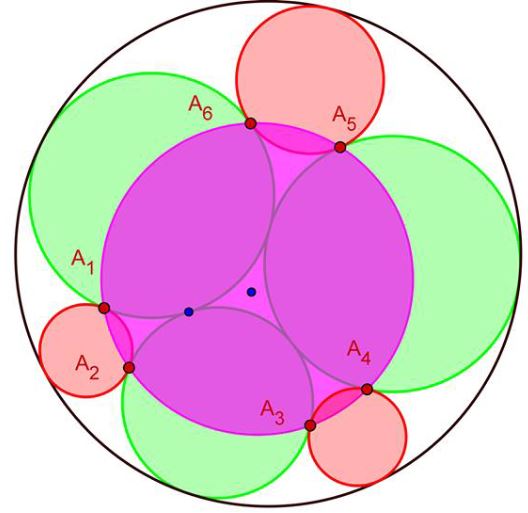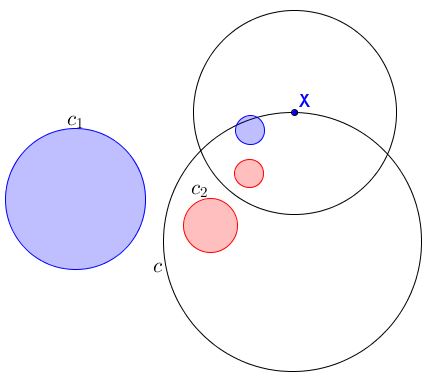Seven and the Eighth Circle Theorem
Problem
Three green circles touch each other externally, and a larger circle $\omega$ internally. Three additional (red) circles each touch externally two of the green neighbors and internally $\omega.$ Points $A_1,$ $A_2,$ $A_3,$ $A_4,$ $A_5,$ $A_6$ are the points of tangency as shown:

Prove that $A_1,$ $A_2,$ $A_3,$ $A_4,$ $A_5,$ $A_6$ are concyclic.
The proof below is based on the following
Lemma
Assume that inversion in circle $c$ maps circle $c_1$ onto circle $c_2.$ Then, for any point $X\in c,$ any inversion with center $X$ maps $c_1$ and $c_2$ into equal circles.

The proof can be found on a separate page.
Proof of the statement
Denote the green circle $G_1,$ $G_2,$ $G_3,$ say $G_{1}=(A_{6}A_{1}),$ $G_{2}=(A_{2}A_{3}),$ $G_{3}=(A_{4}A_{5}).$ Circles $G_1,$ $G_2,$ are either equal or not. If they are not, find an inversion that maps one on top of the other (this would be an inversion in a circle centered at their center of similitude and passing through their point of tangency) and, following the lemma, another one that maps them into equal circles. The whole configuration will be inverted into an essentially same configuration but with two green circles $G_1,$ $G_2$ equal.
Any inversion centered on the common tangent of $G_1,$ $G_2$ (i.e., their radical axis) will keep their images equal. If $G_3$ is equal to the other two, we are done. If not, find an inversion that maps $G_1,$ $G_3$ onto each other. This is an inversion in the circle centered at their center of similitude and passing through their point of tangency. This circle is bound to cross the radical axis of $G_1,$ $G_2$ because this is where - due to the acquired symmetry - $G_3$ is now centered. Use the point of intersection to invert all three circles into equal ones.
In a configuration where all three green circles are equal, the six points $A_1,$ $A_2,$ $A_3,$ $A_4,$ $A_5,$ $A_6$ are concyclic due to the symmetry of the configuration. Performing the sequence of inversions backwards shows that the same is true for the original configuration.
Acknowledgment
The problem has been posted by Dao Thanh Oai (Vietnam) at the CutTheKnotMath facebook page. Lemma is problem 3.8.15 from H. Eves, A Survey of Geometry.
Inversion - Introduction
- Angle Preservation Property
- Apollonian Circles Theorem
- Archimedes' Twin Circles and a Brother
- Bisectal Circle
- Chain of Inscribed Circles
- Circle Inscribed in a Circular Segment
- Circle Inversion: Reflection in a Circle
- Circle Inversion Tool
- Feuerbach's Theorem: a Proof
- Four Touching Circles
- Hart's Inversor
- Inversion in the Incircle
- Inversion with a Negative Power
- Miquel's Theorem for Circles
- Peaucellier Linkage
- Polar Circle
- Poles and Polars
- Ptolemy by Inversion
- Radical Axis of Circles Inscribed in a Circular Segment
- Steiner's porism
- Stereographic Projection and Inversion
- Tangent Circles and an Isosceles Triangle
- Tangent Circles and an Isosceles Triangle II
- Three Tangents, Three Secants
- Viviani by Inversion
- Simultaneous Diameters in Concurrent Circles
- An Euclidean Construction with Inversion
- Construction and Properties of Mixtilinear Incircles
- Two Quadruplets of Concyclic Points
- Seven and the Eighth Circle Theorem
- Invert Two Circles Into Equal Ones
![]()
|Contact| |Front page| |Contents| |Geometry| |Eye opener|
Copyright © 1996-2018 Alexander Bogomolny
73578565
